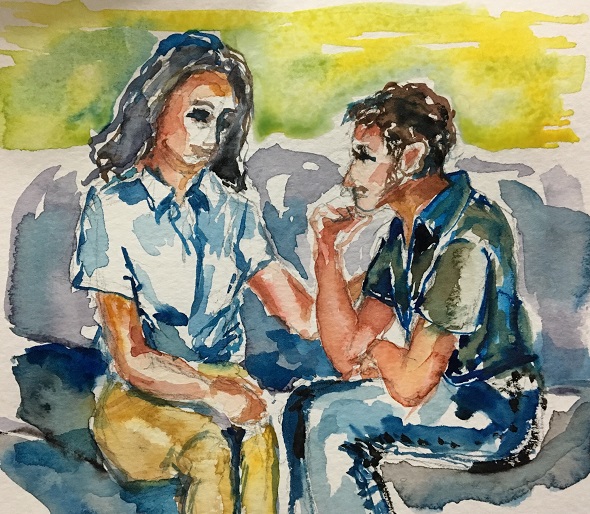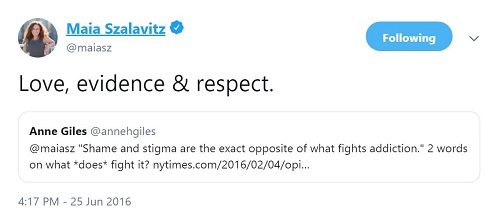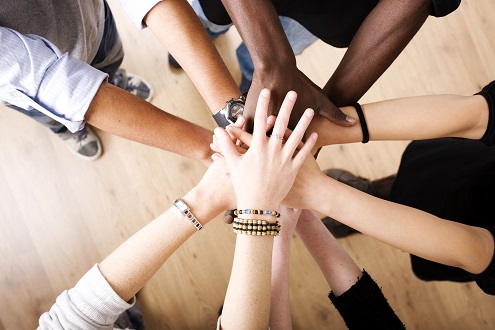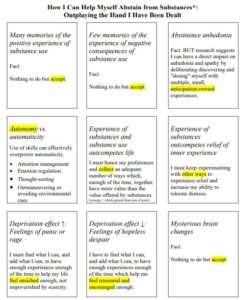This is the central question I urge people to ask counselors, program directors, and other potential providers of treatment for substance use concerns:
“Do you provide research-informed care?”
The common belief is that people who overuse substances need to “go to rehab.” Estimated rates of return to substance use after attending in-patient treatment are 70% or higher in the first three to six months. Recent discussion about the effectiveness of vaccines helps give this number perspective. Rehab has a 30% effectiveness rate. Out of 10 people who attend, only 3 become “protected.” With this poor showing, would we even consider this procedure “effective,” much less offer it nationwide as a “treatment”?

So why don’t rehabs “work”? Why do few “treatments” for substance use concerns reduce or eliminate use?
Because people use substances for reasons.
If the needs and wants met by substance use aren’t identified and ameliorated, if individually meaningful alternatives aren’t found, the reasons still exist and substances will continue to work to address them.
Brain automaticity and other features of substance overuse revealed by neuroscience – usually termed “addiction” – add an additional layer of complexity. Many of these mechanisms can be assisted with medications.
Even if, hypothetically, all the brain mechanisms involved in addiction could be stabilized or reversed, the reasons the person used substances still exist. Particularly if substance use provides relief from physical, mental, or emotional pain, the likelihood of return to use, and perhaps overuse, is high.
For example, given the initial euphoric, then sedative effects of ethyl alcohol, it is perfectly understandable that Americans increased their use of alcohol during the worst year in the past 100 years of the nation’s history.
A humane, logical, science-informed program for overuse of substances would provide:
- substance use-focused medical care, including a physical, substance use-specific lab work, consideration of medications, and assessment for co-occurring mental disorders, particularly for post-traumatic stress disorder (PTSD), since two-thirds of people with substance use concerns have experienced trauma, particularly in early childhood.
- humane counseling to help discover and address reasons for use,*
- humane cognitive behavior therapy (CBT) to help the person learn to override brain automaticity, and
- financial support so the person can focus on addressing what can become life-threatening overuse of substances.
I know of no program like this. (With great difficulty in a rural area, I attempt to cobble together such a program through my solo practice and through coordinated efforts with other health care professionals.) The only description of a program I can find that comes close is Alltyr in Minnesota and services are offered outpatient-only. I know of no one who has received services at Alltyr so I can’t offer more than a link.
Let’s say a person were handed a brochure describing a program that included numbers 1-4 above. Why might people balk at engaging in such a program?
First, they probably wouldn’t believe the description or the claims. Little about what the treatment industry, media, most health care professionals, one’s family, and people in line at the grocery store have to say about substance use engenders trust. The American way is to blame individuals for causing their own health problems. When I seek treatment for myself or accompany others who seek treatment, I mentally carry a length of 2″ x 4″ in my purse to get providers to back off. I am grateful when what is said is merely insensitive or uninformed. It’s usually cruel.
Second, no one wants to have a stigmatized condition. Substance use, “recovery” from substance overuse, having had “a problem with substances” – all of these are stigmatized, i.e. people lose face and status in society, and can lose or be denied jobs, lose custody of their children, even lose their freedom.
Third, the ardent wish of people that things aren’t the way they are, plus their fear of what they believe overuse of substances may mean about themselves and their lives, are powerful forces. Acknowledging realities as they are takes bravery beyond the pale.
Let’s say the person does enter the humane program and the providers speak humanely and informedly.
The deal on offer is still a bad one.
A cost-benefit analysis shows why.
The purpose of substance use is to take the brain where it can’t normally go by itself. Never again having that experience through abstention, or having a lesser experience through reduced use, plus brain structures involved with bonding and attachment, all create an experience of painful, irreparable loss.
A program has to offer what substances offer, or near enough, to make the trade worth it. Plus, the program has to offer a way to co-travel with grief. In other words, the benefits of reducing use or abstaining from use have to outweigh the costs. That’s not moral or spiritual. That’s plain ol’ human logic.
“If they truly loved me, they would stop.” That statement is hardest to hear from children, but I hear it from partners and parents as well. Substance use isn’t about love. Substance use is complexly and dynamically about the needs and wants that substances fill, plus the brain structures and functions that create longing and automaticity.
Alcohol overuse is particularly problematic, especially if the person has been to a 12-step meeting. Step 1 states, “We admitted we were powerless over alcohol, that our lives had become unmanageable.” On the contrary, self-efficacy – the ability to intend to do something and to do it – relies on gathering and using personal power. A meta-analysis conducted by Lance Dodes, M.D., calculated that 14 out of 15 return to use of alcohol if they use a 12-step approach as “treatment.”
If rehab is the plan, however, in addition to asking, “Do you provide research-informed care?”, I urge people to ask potential providers these questions;
- What is your outcome data? a) What percentage of people who enter the program complete it? b) How do you define “success” or remission? c) Among those who complete the program, what percentage are “successful”/in remission one year later?
- What medical professionals are on-site 24-7? What medical care do you provide? What medical care do you coordinate with outside providers?
- Is your program abstinence-based? Do you offer moderated use and/or harm reduction options?
- Is support group attendance required? Do you offer support group meetings other than 12-step? Which ones?
- Are your patients with opioid use disorder allowed buprenorphine? [The only evidence-based treatments for the medical condition of opioid use disorder (OUD) are the medications methadone and buprenorphine. Denying people medication for OUD can result in their deaths.]
- Do you screen for trauma? If so, what counseling protocols do you use to address trauma? [Cognitive Processing Therapy (CPT) and Cognitive Behavior Therapy (CBT) for PTSD are the protocols with the largest evidence base. Other protocols have vocal fans and may have some research to support them, but why use lesser protocols when gold standard protocols are readily available?]
- Are patients allowed to smoke?
- Are patients allowed to have phones?
- How many individual counseling sessions are offered per week? What counseling protocols do your therapists use in individual sessions? (Listen for CBT and DBT, the only protocols with extensive research backing to assist with substance use disorder.)
- How many group sessions are offered per week? What counseling protocols are used in group sessions? (General group counseling has been shown to not be an effective approach to addressing substance use concerns.)
- When patients aren’t in individual and group counseling sessions, how do they spend their time?
The topics in these questions are the usual sticking points that differentiate a belief-based program from a program that is at least trying to align itself with science.
In sum, interrogate rehabs before committing to losing that much money from a house or retirement fund or taking on a second mortgage, to having in-patient treatment in one’s personal health record for the rest of one’s life, to losing that much irreplaceable time at work and/or with partners and families, all the while having a 3 in 10 chance of achieving desired outcomes.
According to research, most people reduce use naturally, on their own, without treatment. How? In a nutshell, they figure out what substances do for them and find other ways to get those things done, or they discover more meaningful, rewarding, and/or engaging things to do. Any effort, whether through informal means or a formal program, that doesn’t help people with the reasons they use substances, is unlikely to be very helpful and, as is often the case, can cause harm.
I use the word “humane” often and deliberately in this post. In my experience, humanity is rare in the treatment industry. But, humans have used substances for over 12,000 years and, for between 70-80% of people who use drugs, there’s no issue. When people overuse substances in ways that harm themselves or others, this is a very human concern which, in my opinion, merits our deepest humanity.
As a public service, I have posted a free, online course on Udemy for people with substance use concerns: Research-Backed Ways to Reduce or Eliminate Substance Use. Here’s an introduction to the course and here’s the direct link.
*To independently consider the reasons one might overuse substances, completing these might be helpful:
- Self-Care Checklist
- Awareness Skills Self-Assessment
- Checklists to Assess Needs, Wants, Strengths and Preferences
- Values and Priorities Exercises
Other posts on this site may be of assistance:
- Questions to Ask and Answer to Reduce Substance Use
- If You Have Begun to Drink and Use More Than You Wish
- Insider’s Guide to Early Abstinence
- Help That Helps: A Kind, Research-Informed, Field-Tested Guide for People with Substance Use Concerns, co-authored with Sanjay Kishore, M.D.
- I Am a Person with the Health Condition of Addiction
- A Typical Day in the Life of a Person Practicing Evidence-Based Treatment for Addiction
- How to Help a Loved One with Addiction: An Evidence-Informed Approach
- How to Help People With Addiction Who Are Mandated to Abstinence
- Guide for Parents and Partners of People with Substance Use Concerns
“It’s my life. Don’t you forget.”
– It’s My Life, Talk Talk
With any questions at all, please contact me.
Watercolor by Jesi Pace-Berkeley
The views expressed are my own. This content is for informational purposes only and is not a substitute for medical or professional advice. Consult a qualified health care professional for personalized medical and professional advice.

 Look at the permutations of thoughts that can arise from the “I am bad”/”I do badly”/just-world belief scenario:
Look at the permutations of thoughts that can arise from the “I am bad”/”I do badly”/just-world belief scenario:
 Using the proverbial metaphor of life as a card game, wishing to return to use is a card I’ve been dealt. It’s a fact. What other cards are on the table?
Using the proverbial metaphor of life as a card game, wishing to return to use is a card I’ve been dealt. It’s a fact. What other cards are on the table? 
